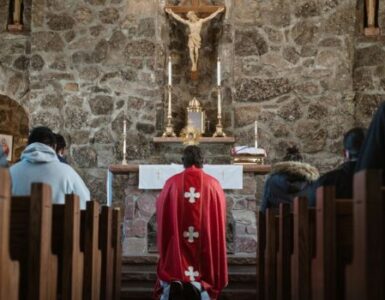Since the Fourth Century, Catholics have been devoted to Saint Agnes, the young virgin martyr from Rome who died in the year 304. Her feast day has been celebrated since 354 on January 21. Saint Agnes is one of the seven women martyr saints named in the Roman Canon of the Mass. Some of the Fathers of the Church, including Saint Ambrose, Saint Augustine, and Saint Jerome have written about her. Saint Ambrose’s account of her life, from his Treatise on Virgins is included in the Office of Readings for the Liturgy of the Hours on Saint Agnes’ feast day.
According to the traditional stories of her life, Agnes, a very devout, beautiful Roman girl, had consecrated her virginity to Jesus. When she was around twelve years old, she began to receive proposals of marriage from some young Roman noblemen. Agnes told them that she belonged completely to Jesus and He was her spouse. One man, the son of the city prefect, was so angered by her refusal that he reported her to his father as a Christian. This was during the time of the persecution of Christians by the Emperor Diocletian. Agnes demonstrated great courage when she was arrested and remained strong in her faith, despite being threatened with torture. Witnesses cried to see that Agnes, still a child, would be martyred. She, however, in the words of Saint Ambrose: “joyfully went to the place of punishment with hurrying step”. She did not even seem afraid when shown instruments of torture. She was willing to suffer for love of Jesus. When ordered to offer incense before the pagan idols, Agnes refused and made the sign of the cross over their altars. The prefect then threatened to send her to a house of prostitution. She told him, “You may stain your sword with my blood, but you will never be able to profane my body, consecrated to Christ.” God protected her as she knew He would. The men there were in awe of her holiness and did not dare to go near her. According to tradition, one man either looked at her or insulted her and was instantly blinded and fell to the ground. Agnes forgave the man and performed the miracle of restoring his vision. The prefect then tried to persuade her to marry. She told him: “It would be an injury to my spouse to look on anyone as likely to please me. He who chose me first for Himself shall receive me.” Agnes even asked the executioner why he delayed. After praying, she bent her neck to be beheaded. The executioner seemed fearful and upset as he executed this innocent young girl. Saint Ambrose wrote, “You have then in one victim a twofold martyrdom, of modesty and of religion. She both remained a virgin and she obtained martyrdom.” Agnes’ body was buried in Rome near the Via Nomentana. Around 354, the Emperor Constantine’s daughter, Constantina, had a basilica built over her grave.
Saint Agnes is a wonderful role model for teenagers and young adults, especially young women. In a time when too few young people want to live as faithful Catholics, Saint Agnes offers the example of such love and dedication to Jesus that she was willing to die as a martyr for the Faith. In a time when chastity is not valued, Saint Agnes shows the beauty of consecrated virginity offered for love for Jesus. Although very young, Saint Agnes demonstrated amazing spiritual maturity. She realized her vocation was to be a spouse of Christ and remained faithful to her vow of virginity. She bravely proclaimed she was a Christian when arrested and gave great witness to her faith in God. She had complete trust in God to protect her virginity and to give her eternal life with Him in heaven. With such great faith, she was not afraid of torture or death, and was able to remain joyful, knowing she would soon be with Jesus. However, Saint Agnes is not just a saint for the young. Catholics of all ages can learn from her story and seek her intercession.
Father Ignatius, my spiritual father and a priest for sixty-six years, is someone who has had a great devotion to Saint Agnes since he was a child. He told me that she has taken good care of him all his life. He had the experience once of receiving a sign of her presence. Several years ago, when leading a pilgrimage in Rome, he suddenly had a strong feeling that he should look up. He looked up and saw in front of him, the Church of Saint Agnes.
Saint Agnes is usually depicted in art with a lamb. The Church has a beautiful tradition of the Pope blessing two white lambs on Saint Agnes’ feast day. The lambs’ wool is used to make the pallia for the new archbishops in the Church.
The name Agnes comes from the Latin word for lamb and the Greek word for purity. Agnes is a fitting name for this saint because of her innocence and chastity. Like a little lamb, she followed her Good Shepherd faithfully and desired to live in union with Jesus, Who is the Lamb of God.
A Prayer to Saint Agnes
Almighty ever-living God,
who chose what is weak in the world to confound the strong,
mercifully grant,
that we, who celebrate the heavenly birthday of your Martyr, Saint Agnes,
may follow her constancy in the faith.
Through our Lord Jesus Christ, your Son,
who lives and reigns with you in the unity
of the Holy Spirit,
God for ever and ever.
(Collect of the Mass on the Memorial of Saint Agnes)
Image: Saint Agnes, Cesare Dandini. Public domain.













